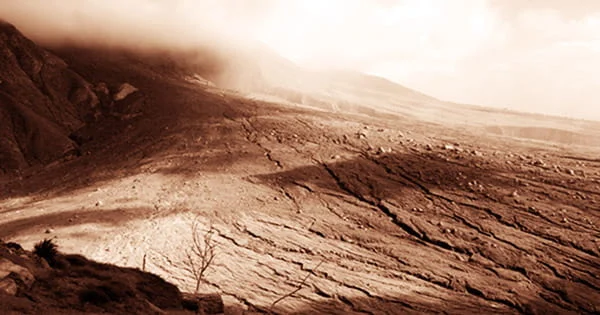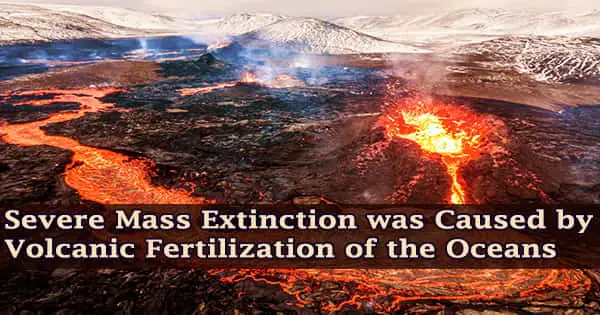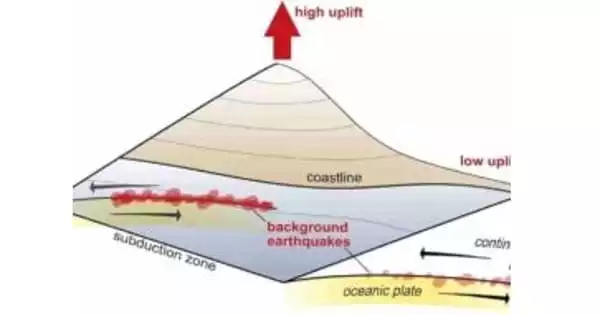Two powerful phases of volcanism sparked a period of global cooling and dropping oxygen levels in the oceans, resulting in one of the most devastating mass extinctions in Earth history, according to scientists from the University of Southampton.
The researchers investigated the impact of volcanic ash and lava on ocean chemistry during a period of significant environmental change around 450 million years ago, in collaboration with colleagues from the University of Oldenburg, the University of Leeds, and the University of Plymouth. Their findings have been published in Nature Geoscience.
During this time, the world experienced extreme cooling, culminating in a glacier and the huge ‘Late Ordovician Mass Extinction.’ This extinction resulted in the extinction of around 85 percent of ocean-dwelling organisms, changing the evolution of life on Earth.
“It’s been suggested that global cooling was driven by an increase in phosphorus input to the oceans,” says Dr. Jack Longman, lead author of the study based at the University of Oldenburg, and previously a postdoctoral researcher at Southampton.
Several scientists have suggested that we could “engineer” our environment to counteract rising carbon dioxide levels in the atmosphere. One idea is to “fertilize” the water to encourage phytoplankton blooms, which are microscopic organisms that resemble plants and are the “primary producers” of the seas.

Phytoplankton uses sunshine and nutrients to thrive, then becomes food for other marine creatures, absorbing carbon dioxide along the way. The geoengineers argue that adding enough iron in the proper spots, a mineral that is often in poor supply in the open ocean, will cause phytoplankton to flourish profusely and absorb a large amount of CO2.
Phosphorus is one of the most important elements in life, controlling how quickly microscopic aquatic organisms like algae can transform carbon dioxide (CO2) into organic matter through photosynthesis. These animals eventually sink to the seafloor and are buried, lowering carbon dioxide levels in the atmosphere and causing cooling.
“The unresolved puzzle is why glaciation and extinction occurred in two distinct phases at this time, separated by about 10 million years,” states Dr. Tom Gernon, Associate Professor at the University of Southampton and co-author of the study. “That requires some mechanism to pulse the supply of phosphorus, which is hard to explain.”
It’s been suggested that global cooling was driven by an increase in phosphorus input to the oceans.
Dr. Jack Longman
Two extremely significant bursts of volcanic activity across the globe, happening in regions of modern-day North America and South China, coincided very closely with the two maxima in glaciation and extinction, according to the researchers.
“But intense bursts of volcanism are more typically linked to massive CO2 release, which should drive global warming, so another process must be responsible for sudden cooling events,” explains Dr. Gernon.
This prompted the researchers to wonder if the rise in phosphorus needed to explain the glaciations could have come from a subsequent process of natural breakdown or ‘weathering’ of the volcanic debris.
“When volcanic material is deposited in the oceans it undergoes rapid and profound chemical alteration, including release of phosphorus, effectively fertilizing the oceans,” states co-author Professor Martin Palmer from the University of Southampton. “So, it is seemed viable hypothesis and certainly one worth testing.”
“This led our team to study volcanic ash layers in much younger marine sediments to compare their phosphorus contents before and after they were modified by interactions with seawater,” said Dr. Hayley Manners, a lecturer in Organic Chemistry at the University of Plymouth.
The team was better able to evaluate the probable geochemical impact of broad volcanic strata from massive eruptions throughout the Ordovician with this knowledge.
“This prompted us to develop a global biogeochemical model to understand the knock-on effects on the carbon cycle of rapidly adding a surge of phosphorus leached from volcanic deposits into the ocean,” says Dr. Benjamin Mills, Associate Professor at the University of Leeds and co-author on the study.
The researchers determined that blankets of volcanic material put down on the seafloor during the Ordovician Period released enough phosphorus into the ocean to trigger a cascade of events that included climatic cooling, glaciation, broad reductions in ocean oxygen levels, and mass extinction.
While it may be tempting to believe that adding phosphorus to the oceans could help solve the present climate catastrophe, scientists warn that this could have far more negative implications.
“Excess nutrient runoff from sources like agricultural fertilizers is a major cause of marine eutrophication where algae grow rapidly and then decay, consuming oxygen and causing substantial damage to ecosystems at the present day,” cautions Dr. Mills.
Massive volcanic eruptions can warm the climate via CO2 emissions on short timescales, but they can also cause global cooling over multimillion-year timescales, according to scientists.
“Our study may prompt reinvestigations of other mass extinctions during Earth history,” concludes Dr. Longman.
















